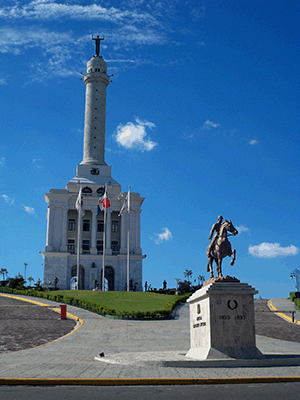|
The province of Santiago is located in the northern Dominican Republic, specifically in the heart of the Valle del Cibao. Bordered on the north of Puerto Plata province, east of the Espaillat Province, west by
the provinces of Santiago Rodríguez and Valverde, and south by the provinces of San Juan and La Vega. It is comprised of nine municipalities and 17 municipal
districts. The municipalities are Santiago de los Caballeros, Licey, Tamboril, Puñal, Villa Gonzalez, Villa Bisono, San Jose de las Matas, Sabana Iglesia, and Janico.
Santiago was founded in 1495 by the Yaque del Norte River, and then moved to the community of Jacagua, where it remained until 1562,
before being moved to where it is today because of an earthquake. This is the first American city to be called Santiago.
The province of Santiago has been the birthplace of the great movements for independence that made the Dominican nation free. It was
capital of the Dominican Republic during the War of Restoration (1863-1865), and has had important figures in the political, economic and social development.
Santiago de los Caballeros is considered after Santo Domingo, the second most important city in the country and its economy is of great importance in the national economic development. The main economic
activities are: the tobacco industry, livestock, agriculture, the rum industry and free zones, among others.
The area ofeducation has several universities and technical and vocational training such as: Pontificia Universidad Catolica Madre y Maestra (PUCMM), Universidad Tecnológica
de Santiago (UTESA), Dominican University Organization and Methods (O & M), Centro Universitario Regional de Santiago (CURSA), The Open University for Adults (UAPA), Center for Technology and Continuing Education (TEP) and The
Institute of Technical and Vocational Training (Infotep).
The cultural area has the Gran Teatro del Cibao, Casa de la Cultura, Centro de la Cultura, Casa de Arte, La 37 por las
Tablas, Museo de Arte Folclórico Tomás Morel, Museo Histórico Fortaleza San Luís, Museo del Tabaco, and Eduardo León Jiménez Cultural Center. Among
its outstanding urban attractions: Santiago Apóstol Cathedral, Consistorial Palace, the Cibao Stadium, and the Monument to the Heroes of the Restoration.
One of the most beautiful traditions that Santiago has preserved so far are horse-drawn carriages and traditional carnival, which is
characterized by the representations of fictional characters, mostly created by people's imagination.
|

|

